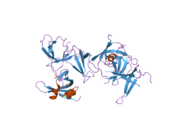SPIN1
Protein-coding gene in the species Homo sapiens
| SPIN1 | |||||||||||||||||||||||||||||||||||||||||||||||||||
|---|---|---|---|---|---|---|---|---|---|---|---|---|---|---|---|---|---|---|---|---|---|---|---|---|---|---|---|---|---|---|---|---|---|---|---|---|---|---|---|---|---|---|---|---|---|---|---|---|---|---|---|
 | |||||||||||||||||||||||||||||||||||||||||||||||||||
| |||||||||||||||||||||||||||||||||||||||||||||||||||
| Identifiers | |||||||||||||||||||||||||||||||||||||||||||||||||||
| Aliases | SPIN1, SPIN, TDRD24, spindlin 1 | ||||||||||||||||||||||||||||||||||||||||||||||||||
| External IDs | OMIM: 609936; MGI: 109242; HomoloGene: 55983; GeneCards: SPIN1; OMA:SPIN1 - orthologs | ||||||||||||||||||||||||||||||||||||||||||||||||||
| |||||||||||||||||||||||||||||||||||||||||||||||||||
| |||||||||||||||||||||||||||||||||||||||||||||||||||
| |||||||||||||||||||||||||||||||||||||||||||||||||||
| |||||||||||||||||||||||||||||||||||||||||||||||||||
| |||||||||||||||||||||||||||||||||||||||||||||||||||
| Wikidata | |||||||||||||||||||||||||||||||||||||||||||||||||||
| |||||||||||||||||||||||||||||||||||||||||||||||||||
Spindlin-1 is a protein that in humans is encoded by the SPIN1 gene.[5][6]
References
- ^ a b c GRCh38: Ensembl release 89: ENSG00000106723 – Ensembl, May 2017
- ^ a b c GRCm38: Ensembl release 89: ENSMUSG00000021395 – Ensembl, May 2017
- ^ "Human PubMed Reference:". National Center for Biotechnology Information, U.S. National Library of Medicine.
- ^ "Mouse PubMed Reference:". National Center for Biotechnology Information, U.S. National Library of Medicine.
- ^ Gao Y, Yue W, Zhang P, Li L, Xie X, Yuan H, Chen L, Liu D, Yan F, Pei X (Aug 2005). "Spindlin1, a novel nuclear protein with a role in the transformation of NIH3T3 cells". Biochem Biophys Res Commun. 335 (2): 343–50. doi:10.1016/j.bbrc.2005.07.087. PMID 16098913. S2CID 44944387.
- ^ "Entrez Gene: SPIN1 spindlin 1".
Further reading
- Oh B, Hwang SY, Solter D, Knowles BB (1997). "Spindlin, a major maternal transcript expressed in the mouse during the transition from oocyte to embryo". Development. 124 (2): 493–503. doi:10.1242/dev.124.2.493. PMID 9053325.
- Hartley JL, Temple GF, Brasch MA (2001). "DNA cloning using in vitro site-specific recombination". Genome Res. 10 (11): 1788–95. doi:10.1101/gr.143000. PMC 310948. PMID 11076863.
- Wiemann S, Weil B, Wellenreuther R, et al. (2001). "Toward a catalog of human genes and proteins: sequencing and analysis of 500 novel complete protein coding human cDNAs". Genome Res. 11 (3): 422–35. doi:10.1101/gr.GR1547R. PMC 311072. PMID 11230166.
- Simpson JC, Wellenreuther R, Poustka A, et al. (2001). "Systematic subcellular localization of novel proteins identified by large-scale cDNA sequencing". EMBO Rep. 1 (3): 287–92. doi:10.1093/embo-reports/kvd058. PMC 1083732. PMID 11256614.
- Strausberg RL, Feingold EA, Grouse LH, et al. (2003). "Generation and initial analysis of more than 15,000 full-length human and mouse cDNA sequences". Proc. Natl. Acad. Sci. U.S.A. 99 (26): 16899–903. Bibcode:2002PNAS...9916899M. doi:10.1073/pnas.242603899. PMC 139241. PMID 12477932.
- Ota T, Suzuki Y, Nishikawa T, et al. (2004). "Complete sequencing and characterization of 21,243 full-length human cDNAs". Nat. Genet. 36 (1): 40–5. doi:10.1038/ng1285. PMID 14702039.
- Humphray SJ, Oliver K, Hunt AR, et al. (2004). "DNA sequence and analysis of human chromosome 9". Nature. 429 (6990): 369–74. Bibcode:2004Natur.429..369H. doi:10.1038/nature02465. PMC 2734081. PMID 15164053.
- Gerhard DS, Wagner L, Feingold EA, et al. (2004). "The status, quality, and expansion of the NIH full-length cDNA project: the Mammalian Gene Collection (MGC)". Genome Res. 14 (10B): 2121–7. doi:10.1101/gr.2596504. PMC 528928. PMID 15489334.
- Wiemann S, Arlt D, Huber W, et al. (2004). "From ORFeome to biology: a functional genomics pipeline". Genome Res. 14 (10B): 2136–44. doi:10.1101/gr.2576704. PMC 528930. PMID 15489336.
- Mehrle A, Rosenfelder H, Schupp I, et al. (2006). "The LIFEdb database in 2006". Nucleic Acids Res. 34 (Database issue): D415–8. doi:10.1093/nar/gkj139. PMC 1347501. PMID 16381901.
- Jiang F, Zhao Q, Qin L, et al. (2006). "Expression, purification, crystallization and preliminary X-ray analysis of human spindlin1, an ovarian cancer-related protein". Protein Pept. Lett. 13 (2): 203–5. doi:10.2174/092986606775101661. PMID 16472086.
- Zhao Q, Qin L, Jiang F, et al. (2007). "Structure of human spindlin1. Tandem tudor-like domains for cell cycle regulation". J. Biol. Chem. 282 (1): 647–56. doi:10.1074/jbc.M604029200. PMID 17082182.
- v
- t
- e
PDB gallery
-
 2ns2: Crystal Structure of Spindlin1
2ns2: Crystal Structure of Spindlin1
 | This article on a gene on human chromosome 9 is a stub. You can help Wikipedia by expanding it. |
- v
- t
- e


















